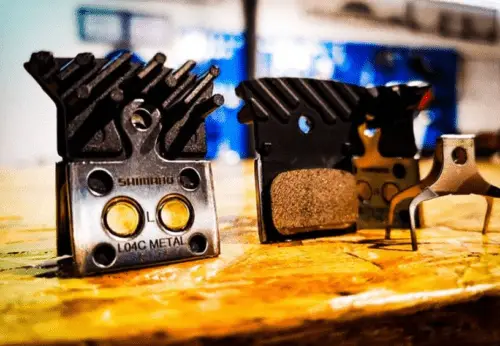
Why Use Metal Brake Pads?
Metal brake pads are quite popular in higher-end disc brakes used in mountain biking. As the name suggests, it is composed of integrated metallic particles. The metal particles are forced to merge when subjected to high pressure and temperature to form a thick plate of metal. It’s natural to think they are always better just because they are featured only with more expensive brakes, however, it’s not always the case.
Pros of metal brake pads:
- Metal brake pads are long-lasting compared to resin brake pads.
- Much better brake power in wet or muddy conditions.
- Resistant to losing brake power when overheated.
- The sintered brake pads are less costly when compared to resin pads due to their longevity.
- High resistance to contamination from oils and other lubricants.
Cons of metal brake pads:
- Metallic brake pads can produce a lot of noise during impact with the rotor.
- The heat produced during friction transfers more easily to the brake fluids.
- Need time to get heated in order to brake properly.
- Rotors last much less if used unheated, therefore best used in situations with a lot of heavy braking.
Heat transfer with metal pads for mineral oil
It is easy to notice that the high temperature generated by the metallic pads on the calipers results in a mineral oil losing a bit of its performance. Mineral oil, unlike the Dot oil, can become a bit compressible if it gets too hot. That’s why cars don’t use mineral oil in brakes. Some bicycle brake manufacturers decide to use mineral oil because it requires less maintenance and isn’t corrosive on the metal parts of the brake. Manufacturers, like Shimano, solved this heat transfer problem by designing their brake calipers to minimalize heat transfer from the brake pad to mineral oil in their system.
Organic Brake pads
They are commonly known as resin or semi-metallic brake pads. A common mistake is thinking there are three types of brakes, third being the semi-metallic while it’s actually the resin brake pad. However, different manufacturers use different metal ratios in their resin pads and that’s where the confusion comes from. They will sometimes even brand them like “semi-metallic” making them seem special. Resin brake pads are mainly organic material. In addition to organic materials, they can include extra materials like rubber and carbon. Therefore resin pads are softer than metallic pads.
Pros
- Quieter than metallic brake pads.
- More linear braking power allowing you to apply braking power better.
- They provide better initial bite than metallic brake pads.
- They do not produce a lot of heat through the system.
Cons
- They are susceptible to contamination when soaked by lubricants.
- Resin pads have a shorter life span, especially in wet conditions.
- They provide poor braking power in wet conditions.
- Less higher-end braking power.
Why resin pads require high maintenance when used in downhill riding
Resin pads are generally suitable in places that do not require frequent breaking since the pads have a low resistance to heat. To clarify, they produce less heat but they are much less resistant to heat as well. Meaning, they lose braking power when they get heated, unlike the metallic brake pads. Therefore any downhill riding is not recommended with resin brake pads. If you still decide to do so, make sure to do regular maintenance to maintain brakes functionality.
Which Brake Pads Are Better For Heavier Riders?
Metal brake pads are mostly better suited for heavy riders. The characteristic features of the pads make them unstoppable even in muddy conditions. In other words, metallic brake pads are better suited for every condition that requires higher braking power. While resin pads are better in situations that require more precise and linear braking with less brake force.
I have a lot of experience with this since my weight fluctuated a lot in recent years. To be exact I’ve gained 55 pounds in 2 years and then lost them again in a year. I’ve realized that when I was heavier, metal brake pads were much better for me. Whenever I reached some technical sections with lots of brake usage the brake power was insufficient for my weight. I could’ve switched to better brakes but the ones I used could go with metal brake pads so that option was cheaper.
Later on, I switched back to resin brake pads since nowadays I’m more into lots of pedaling than technical terrain. I’m back to lower weight as well, so resin pads now give me the ability to brake linear and more precisely.
- Pair of genuine Shimano replacement pads
- Alloy and Steel back plate using Ice-Technologies heat radiation cooling fins with metal sintered braking compound
- J04C metal pad and spring, with cooling fin
- Will fit; BR-M9000, BR-M9020, BR-M8000, BR-M985, BR-M785, BR-M666, BR-S700, BR-R785, BR-RS785
- Shimano article number Y-8LW98
Prices pulled from the Amazon Product Advertising API on:
Product prices and availability are accurate as of the date/time indicated and are subject to change. Any price and availability information displayed on [relevant Amazon Site(s), as applicable] at the time of purchase will apply to the purchase of this product.
Downhill/Enduro vs. XC/Gravel
There is a reason metal brake pads come from factory only on several brake types. Even though they can be used in many brakes and on many rotors that come with the bikes, brands usually decide to put resin brake pads on all the bike models made for easier trails.
Metal brake pads have become a standard on all-mountain and downhill bikes while trail bikes with less suspension travel made for easier trails still most of the time come with resin brake pads.
On cross country bicycles there is still a preference for resin brake pads, however, in recent years there is a trend of riding muddy trails and metal brake pads perform better in these conditions.
All in all, the decision is again quite simple on paper, resin brake pads are better for riding with less braking like XC or gravel, while metal brake pads are better for rides with often braking and the need of more braking power like more technical and downhill trails.
Why should you sand or change the rotors while changing the brake pads?
It is advisable to change the rotors when replacing the brake pads from one to another. After using brake pads for some time, the wear results in a slight film appearing on the rotor. That film is hard to remove with new brake pads of different type and they won’t brake properly until it is done. This leaves us with the conclusion that we can actually remove this layer of old material by ourselves.
I often do this since I was testing both brake pad types for a long time on the same rotors. Most sources recommend 800-1000 grit sandpaper which is reasonable in order to remove the old film. However, I’ve found that using 400 grit sandpaper, in the end, gave the best results. It’s a bit more rugged and I apply it only in the direction of braking by doing circles around the rotor. That was new brake pads apply the new film much quicker and I believe better as well since I’ve seen some increase in braking power after doing this.
This is a decent method but it thins out a rotor really fast. I would still advise changing to new rotors, or simply having two rotors that you can change between, one for each brake type.
Conclusion
Choosing the right type of brake pad depends solely on your style of riding and the places you ride at. If you are going in rough or slope places that require frequent braking, then your best choice is metal brake pads. However, for you that prefer riding in flat areas like country riding, you should pick resin brake pads for maximum performance and longevity.

